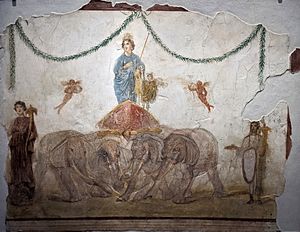Venus (mythology) facts for kids
Quick facts for kids Venus |
|
|---|---|
| Goddess of love, beauty, desire, fertility, prosperity and victory | |
| Member of Dii Consentes | |

Fresco with a seated Venus, restored as a personification of Rome in the so-called "Dea Barberini" ("Barberini goddess"); Roman artwork, dated first half of the 4th century AD, from a room near the Baptistery of San Giovanni in Laterano
|
|
| Planet | Venus |
| Symbols | rose, common myrtle |
| Day | Friday (dies Veneris) |
| Festivals | Veneralia Vinalia Rustica Vinalia Urbana |
| Personal information | |
| Consort | Mars and Vulcan |
| Children | Cupid (in later tradition); Aeneas (fathered by Anchises in Virgil's Aeneas) |
| Parents | Caelus |
| Greek equivalent | Aphrodite |
Venus is a powerful Roman goddess. She was known for love, beauty, desire, and making things grow (fertility). She also brought good luck and helped win battles. In Roman mythology, Venus was very important because the Roman people believed she was their ancestor. Her son, Aeneas, survived the Trojan War and traveled to Italy, starting the Roman line. Even famous leaders like Julius Caesar said Venus was their family's divine ancestor.
The Romans used many stories and images from the Greek goddess Aphrodite to describe Venus. Over time, Venus became a symbol of love in Western culture. Artists often showed her as a beautiful, unclothed figure in paintings and sculptures.
Contents
How Venus Came to Be
Venus didn't have her own birth story until the Romans linked her with the Greek goddess Aphrodite. According to this story, Venus-Aphrodite was born from the sea foam. She appeared as a grown-up, not a baby. In Roman beliefs, Venus was key to creating and balancing life. While gods like Vulcan (god of fire) and Mars (god of war) were strong and active, Venus was seen as someone who could calm and balance their energy. She could also bring victory in war, good fortune, and wealth.
Stories About Venus
Venus had many interesting stories connected to her. One well-known story says that Cupid, the god of love, was the son of Venus and Mars, the god of war. In other tales, Venus was linked with Vulcan, the god of blacksmiths and fire. Sometimes, she was also said to be the mother of another Cupid, whose father was Mercury, the messenger god.
Fun Facts About Venus
- Like other major Roman gods, Venus had many special names. These names showed her different roles and how she was similar to other gods.
- Many temples in Rome were built to honor Venus.
- The name Venus comes from a word that means 'desire' or 'charm'.
- April was Venus's special month. Her sacred day was called dies Veneris, which means "day of Venus." This is why we call the sixth day of the week "Friday" today!
- In ancient times, the Germanic people connected Venus with their own goddess, Frijjo. This is another reason why "Friday" is named after her.
- Julius Caesar believed Venus was his divine protector. She was also the ancestral goddess of his family, the Julian clan.
- In dice games played with knucklebones (a popular Roman game), the best possible roll was called "Venus." This meant you had amazing luck!
- Before getting married, Roman brides would offer a gift to Venus. Some sources say that girls becoming adults would offer their childhood toys to Venus.
- Pictures of Venus have been found in Roman homes, on wall paintings, mosaics, and in small household shrines.
- Venus, the second planet from the Sun and Earth's closest planetary neighbor, is named after this goddess.
Venus in Art
Roman and Greek artists created many different statues and paintings of Venus. These artworks showed her beauty and grace.
Some famous examples of Venus in classical art include:
- Venus de Milo (a famous marble statue from around 130 BC)
- Capitoline Venus
- Venus de' Medici
- Esquiline Venus
- Venus Anadyomene (meaning "Venus rising from the sea")
Venus in Later Art
After the classical period, Venus became a very popular subject for artists during the Renaissance in Europe. It was acceptable to show her unclothed in art because she represented beauty and love. Over time, the word venus even came to mean any artistic picture of a beautiful unclothed woman, even if she wasn't the goddess herself.
Some famous paintings of Venus include:
- The Birth of Venus by Botticelli (around 1485)
- Sleeping Venus by Giorgione (around 1501)
- Venus of Urbino by Titian (1538)
- Rokeby Venus by Velázquez (1647–1651)
Images for kids
See also
 In Spanish: Venus (mitología) para niños
In Spanish: Venus (mitología) para niños
- Venus (planet)




